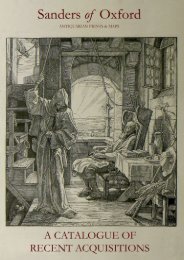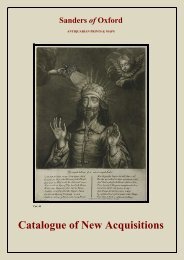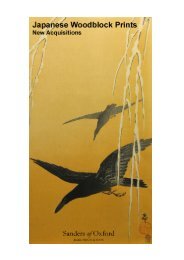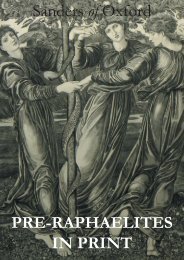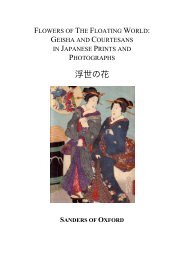Mezzotints & Engravings after J.M.W.Turner.pdf - Sanders of Oxford
Mezzotints & Engravings after J.M.W.Turner.pdf - Sanders of Oxford
Mezzotints & Engravings after J.M.W.Turner.pdf - Sanders of Oxford
You also want an ePaper? Increase the reach of your titles
YUMPU automatically turns print PDFs into web optimized ePapers that Google loves.
Unlike <strong>Turner</strong>’s view <strong>of</strong> Rochester on the River<br />
Medway in which the edifices <strong>of</strong> the former city are<br />
as focal as the ships, Stangate Creek is a far more<br />
maritimal scene. A rowing boat navigates between<br />
buoys and barrels as seagulls flutter overhead. It is<br />
a print in which <strong>Turner</strong>’s masterful use <strong>of</strong> light can<br />
be seen; be it in the subtle reflection <strong>of</strong> the oarsmen,<br />
or the great luminous sword left upon the water by<br />
the sun.<br />
Condition: Foxing to sheet, plate and image. Most<br />
badly affected above the sails <strong>of</strong> the ships and to the<br />
top right-hand corner <strong>of</strong> the mezzotint. Laid on<br />
India paper with full margins.<br />
[27569]<br />
£225<br />
13. [Kirkstall Lock, on the River Aire]<br />
Mezzotint<br />
William Say <strong>after</strong> J.M.W <strong>Turner</strong><br />
Published c.1823 by W.B.Cooke, 9 Soho Square<br />
Image 229 x 154 mm, Plate 254 x 197 mm, Sheet<br />
566 x 388 mm<br />
unmounted<br />
Rawlinson 765. Engraver’s pro<strong>of</strong> before all letters.<br />
Men and woman work amongst blocks <strong>of</strong> stone on<br />
the banks <strong>of</strong> a canal; their labour will eventually<br />
result in Kirkstall brewery. Barges lay dormant and<br />
the gap <strong>of</strong> the viaduct becomes an ellipse in the<br />
reflection <strong>of</strong> the water. Skirted by slopes on either<br />
side <strong>of</strong> it, as well as the sunlit remains <strong>of</strong> Kirkstall<br />
Abbey, the River Aire curves away into the<br />
distance.<br />
William Say (1768-1834) was an English engraver<br />
who worked solely in mezzotint. Born in<br />
Lakenham, near Norwich, he departed for the<br />
capital at the age <strong>of</strong> twenty. Under the guidance <strong>of</strong><br />
James Ward, Say became an able and extremely<br />
industrious engraver. He was one <strong>of</strong> the engravers<br />
employed by <strong>Turner</strong> for the Liber Studiorum; a<br />
project in which Say executed eleven <strong>of</strong> the<br />
published plates. In addition to Kirkstall Lock, on<br />
the River Aire, Say also engraved a view <strong>of</strong><br />
Brougham Castle for the The Rivers <strong>of</strong> England.<br />
These, coupled with a fine view <strong>of</strong> Lincoln<br />
Cathedral <strong>after</strong> Mackenzie, constitute his chief<br />
topographical work in a prolific career dedicated to<br />
Old Master reproductions.<br />
Condition: Foxing to sheet; very light foxing to the<br />
plate and image. A few spots located in the upper<br />
right-hand corner <strong>of</strong> the print. Laid on India paper<br />
with full margins.<br />
[27589]<br />
£225<br />
Acting in the capacity <strong>of</strong> both publisher and<br />
engraver, The Ports <strong>of</strong> England (1826-8) was<br />
conceived by Thomas Lupton and intended to stand<br />
as a companion piece to William Bernanrd Cooke’s<br />
The Rivers <strong>of</strong> England. J.M.W <strong>Turner</strong> was the<br />
commissioned artist, though <strong>of</strong> the twenty-four port<br />
subjects specified in the brief, only twelve were<br />
completed. John Ruskin, the great Victorian critic,<br />
closely collaborated with Lupton on the project and<br />
provided a pr<strong>of</strong>ile <strong>of</strong> each harbour featured within<br />
the volume. The faltering series was revived and<br />
reissued in 1856 by Ernest Gambart under the title<br />
The Harbours <strong>of</strong> England. Subsequent reprints<br />
followed in 1859 and 1872 but these were <strong>of</strong> an<br />
inferior quality. In 1877, Smith, Elder & Co.<br />
published what Rawlinson described as ‘carefully<br />
reworked’ and ‘superior’ versions <strong>of</strong> the original<br />
plates.<br />
Thomas Lupton (1791-1873) was an English<br />
mezzotinter who produced many works by <strong>Turner</strong><br />
as well as a host <strong>of</strong> other notable British painters <strong>of</strong><br />
the nineteenth-century. A talented engraver, Lupton<br />
also played a significant role in the technical<br />
advancement <strong>of</strong> the mezzotint. In the hope <strong>of</strong><br />
finding a more durable replacement for copper<br />
plate, Lupton conducted lengthy experiments on<br />
Chinese tutenag, nickel, and steel. The latter proved<br />
the most perspicacious. So much so that <strong>after</strong> 1,500<br />
impressions, a single s<strong>of</strong>t steel plate could still<br />
produce remarkable prints. Lupton’s endeavour was<br />
recognised by the Royal Society <strong>of</strong> Arts and he was<br />
awarded the Isis medal in 1822.




